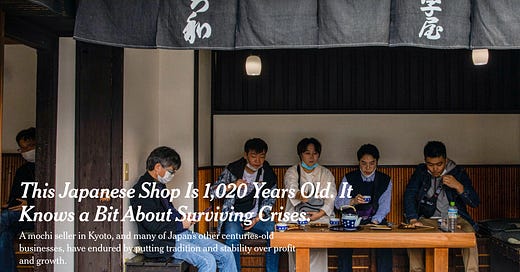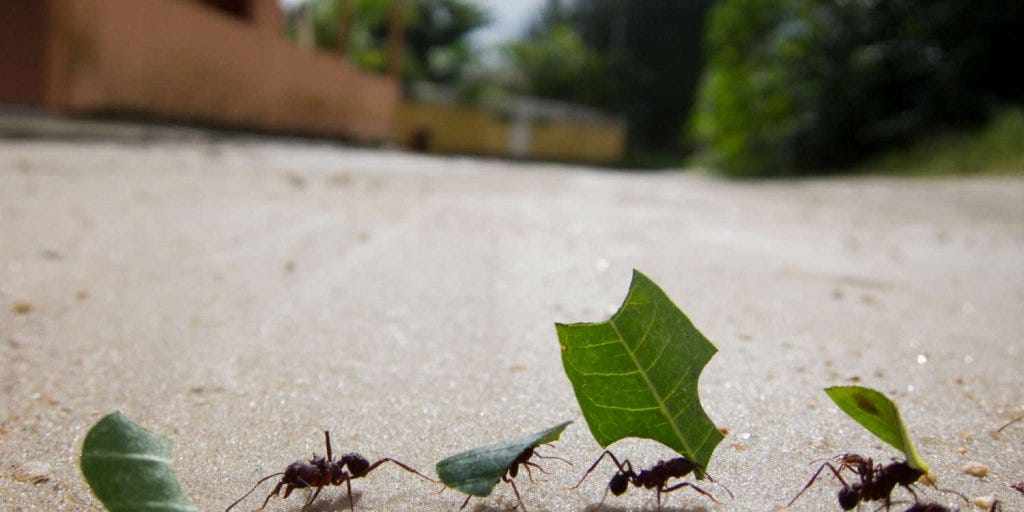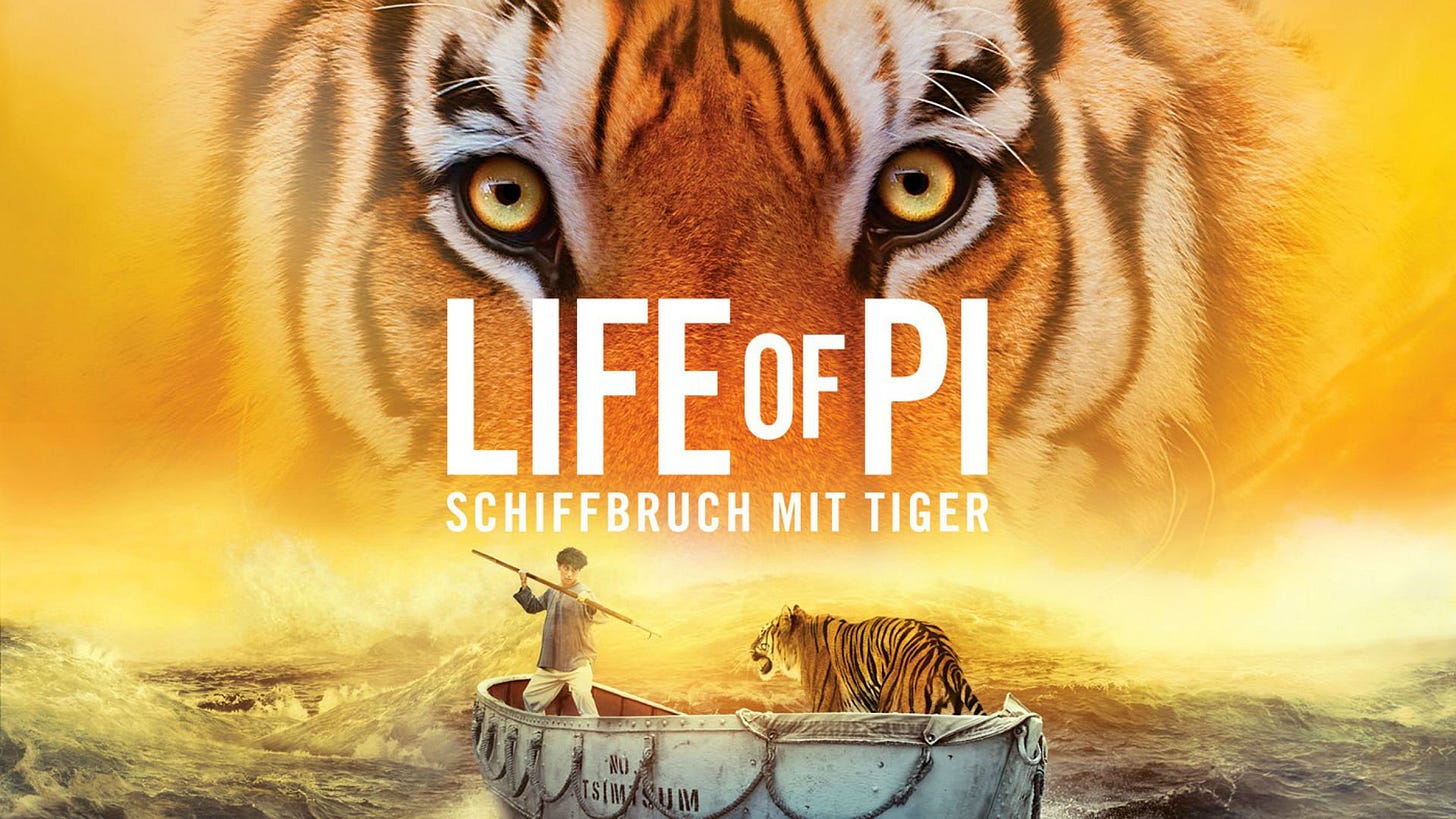Learning Resilience from a 1000-year-old Mochi Shop
I’ve been wanting to write this topic for a while and then earlier this week I read this wonderful article by the NYT.
Among many things it touches on, one of them is what it means to build an enduring business that can last 1000 years.
To quote from the story:
Such enterprises may be less dynamic than those in other countries. But their resilience offers lessons for businesses in places like the United States, where the coronavirus has forced tens of thousands into bankruptcy.
“If you look at the economics textbooks, enterprises are supposed to be maximizing profits, scaling up their size, market share and growth rate. But these companies’ operating principles are completely different,” said Kenji Matsuoka, a professor emeritus of business at Ryukoku University in Kyoto
What’s “different” here is that these resilient enterprises prioritize “prudence and survival” over “optimization and growth”. The mental framework that I use is “resilience” vs “upside”. Just like Yin and Yang, these are two sides of the forces within any organism.
In the animal world, one species that’s known for resilience might be ants. They are built to last. Ants have various roles for each member and you won’t be able to find all of the ants in one place at the same time. If a flash flood takes place and wipes out their original habitat, the rest of the group will continue to build a new one and carry on. That’s the “anti-shock” system that’s build within the organism - and it effectively produces long-lasting resilience.
An opposite example to ants might be large predators such as tigers. As formidable and skillful tigers might appear to be, they live or die based on surrounding preys. In other words, they are extremely dependent on external conditions. In a bad year when a natural disaster happens, tigers often starve to the bone and even to death. But when there are a lot of preys, the pride gets to reproduce quickly and thrive - experiencing rapid growth.
Companies are nothing dissimilar to complex organisms in nature.
Let me also say that not every company can, or should be a 1000-year enterprise; however, I do think many companies ignore to have a long-term point of view, which is why they are subject to existential disruptions every 5 to 10 years.
The truth is that if you’ve been putting your heads down in a box, it’s hard to see rocks falling from the sky.
There should be a balance in between. But in practice, it’s difficult to do.
For many modern enterprises, they are wired to be resource-efficient, growth-hungry, and profit-seeking. And the trend of globalization has even blindly encouraged more of these behaviors from companies in the name of “creating shareholder value.” Both investors and managements have gone along with this setup for too long and that’s why we are seeing companies becoming irrelevant at a much faster pace.
In the world that I live in, both startups and VCs seek “exponential growth” in a large TAM (totally addressable market).
We seek the new variables, the new-comers, and the rule-changes to a large, equilibrium-reached ecosystem.
In the book “Life of Pi”, there was a scene where Pi and Richard Parker (the tiger) found a new strange island where there was nothing else but a sea of meerkats who had never seen a tiger before. The “new variable” of tiger triggered the disruption - the tiger had its feast and the number of meerkats decreased significantly.
I might be the only strange one who thinks about startup growth when I read that scene. But that type of dramatic disruption happens to the brands we live and breathe daily as well.
If we look at this chart:
In a short 10 years, the top 10 positions (in gas, telecom, banking) were mostly replaced by tech companies with a much bigger market cap.
“Software is eating the world” but what will be eating software?
We haven’t properly asked that question yet.
What can the tech industry learn from that 1000-year-old mochi shop and be long-term resilience?
On the risk of being controversial, I might say that if "rapid growth” is easy to find: every iconic company has its S-curve(s) in the early days. But is “rapid growth” and its implied over-optimization always a good force to build a resilience enterprise?
Probably not. In fact, sometimes too fast of an uncontrolled growth can lead to a quick flameout. Just look at Groupon in the US and Ofo Bikes in China.
What we need is a type of compounding growth that can last centuries, if not decades. And you can only obtain that type of growth by constantly generating values for everyone involved - in other words, by constantly creating non-zero-sumness.
Amazon is an example of that - by purposefully not charging consumers the maximum that it can, it generates a massive non-zero-sum marketplace where both buyers and sellers win. With e-commerce being its beachhead, Amazon then allocates capital resources to grocery retail (Wholefoods), IOT (Alexa), and cloud infrastructure (AWS). Each one of the diversified initiatives become a humming engine to extend the company’s life expectancy.
Can the Amazon of the world become a “1000-year mochi shop”?
Maybe, yet somehow it’s a scary thought to have. And that says a lot about where the tech is today.







